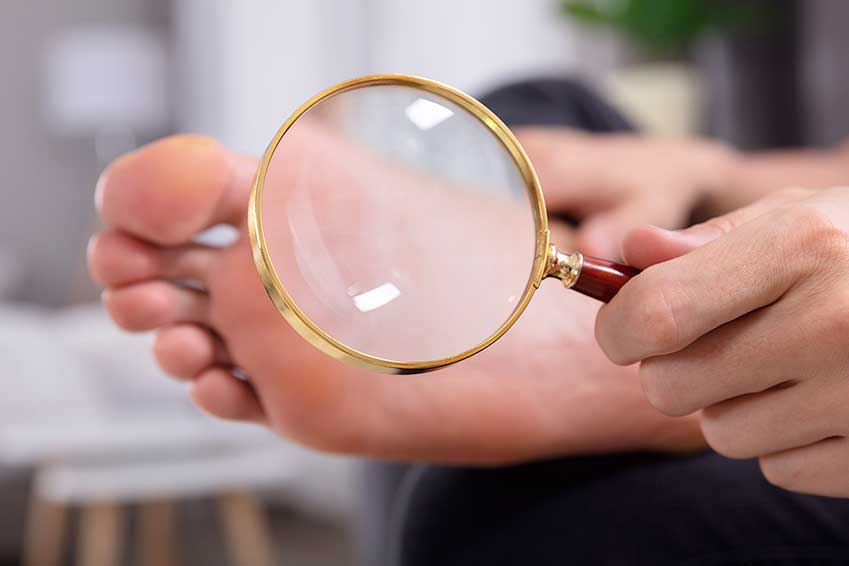 Among the normal population, 30% have bunions, 15 to 25% contend with athlete's foot and 200,000 U.S. men and women suffer from hammertoe. Unfortunately, all of these conditions and more can be exacerbated by diabetes.
Among the normal population, 30% have bunions, 15 to 25% contend with athlete's foot and 200,000 U.S. men and women suffer from hammertoe. Unfortunately, all of these conditions and more can be exacerbated by diabetes.
Learn how diabetes makes you more vulnerable to foot problems and what you can do to prevent them.
How Does Diabetes Impact the Health of My Feet?
When it comes to diabetes and your feet, there are two main culprits that can negatively impact your health: reduced blood flow and nerve damage.
Low blood flow may result in open sores and infections that may not be readily identified and take an especially long time to heal or do not heal at all without special treatment. Persistent, untreated infections can have lasting ramifications – the worst being the death of body tissue. This is called gangrene.
In addition to low blood flow, diabetes causes nerve damage. This type nerve damage in extremities caused by diabetes is referred to as diabetic neuropathy. Symptoms of diabetic neuropathy include tingling, pain and the lack of sensation altogether. Again, sores, cuts and infections are more likely to worsen because patients may not feel them when they occur or detect the root cause of them. In other words, if you cannot feel a pebble in your shoe, it can rub up against your skin causing blisters and sores. The problem may persist for longer because you cannot feel the pebble or irritation that it is causing.
Together, nerve damage and vascular conditions in feet make patients more susceptible to conditions like bunions, calluses, corns, hammertoes, ingrown toenails, athlete's foot, fungal infections, dry, cracked skin and excess swelling in the legs and feet.
What Can I Do to Mitigate Diabetic Foot Problems?
The long list of diabetes-related foot conditions begs the question: what can I do? Start with taking preventative measures. Follow these tips to curtail foot problems and slow the spread of foot and ankle conditions.
- Check feet daily. Diabetic foot care requires regular monitoring. Look for any signs of swelling, pus-filled blisters, unusually warm spots, plantar warts, ingrown toenails, calluses, or cuts and sores. Do this every night before bed. Do not forget to check between your toes!
- Another critical part of foot health as a diabetic is frequent washing. Wash feet with mild soap and water. Water used while washing and rinsing should be lukewarm--never scalding. Use a thermometer to check the temperature. The temperature of the water should be no more than 90 to 95 degrees Fahrenheit. Avoid soaking your feet since doing so can dry them out and cause more problems. Sprinkle recently dried feet with talcum powder or baby powder to prevent them from getting too dry.
- Wear shoes and socks whenever possible. Diabetic patients should wear shoes and socks at all times, even inside.
- Protect feet from extreme temperatures. Wear full-cover shoes on the beach and always liberally apply sunscreen. At nighttime, wear socks to bed if your feet tend to run cold.
- Most importantly, do not ignore telltale signs of infection, like visible irritation or foot pain. When in doubt, talk to a diabetic foot specialist.
If preventative measures do not nip foot problems in the bud, schedule an appointment with a podiatrist sooner rather than later. Problems are easier to treat in the early and middle stages than in the late stages.
What can you expect at the foot doctor? Depending on your condition, some treatments may be relatively painless and may entail courses of antibiotics or antifungals, corrective footwear, shoe inserts, compression wraps, or splints and braces. In more severe cases, some bunions and hammertoes may require surgical removal. When gangrene is present, it is always absolutely necessary to remove dead tissue before it spreads to other parts of the foot, ankle or leg.
Foot conditions among diabetic patients are common! Just remember to keep your blood sugar levels in range, exercise regularly, eat healthily and take medications from your doctor dutifully and schedule regular visits to your podiatrist to prevent complications and preserve your foot health.

